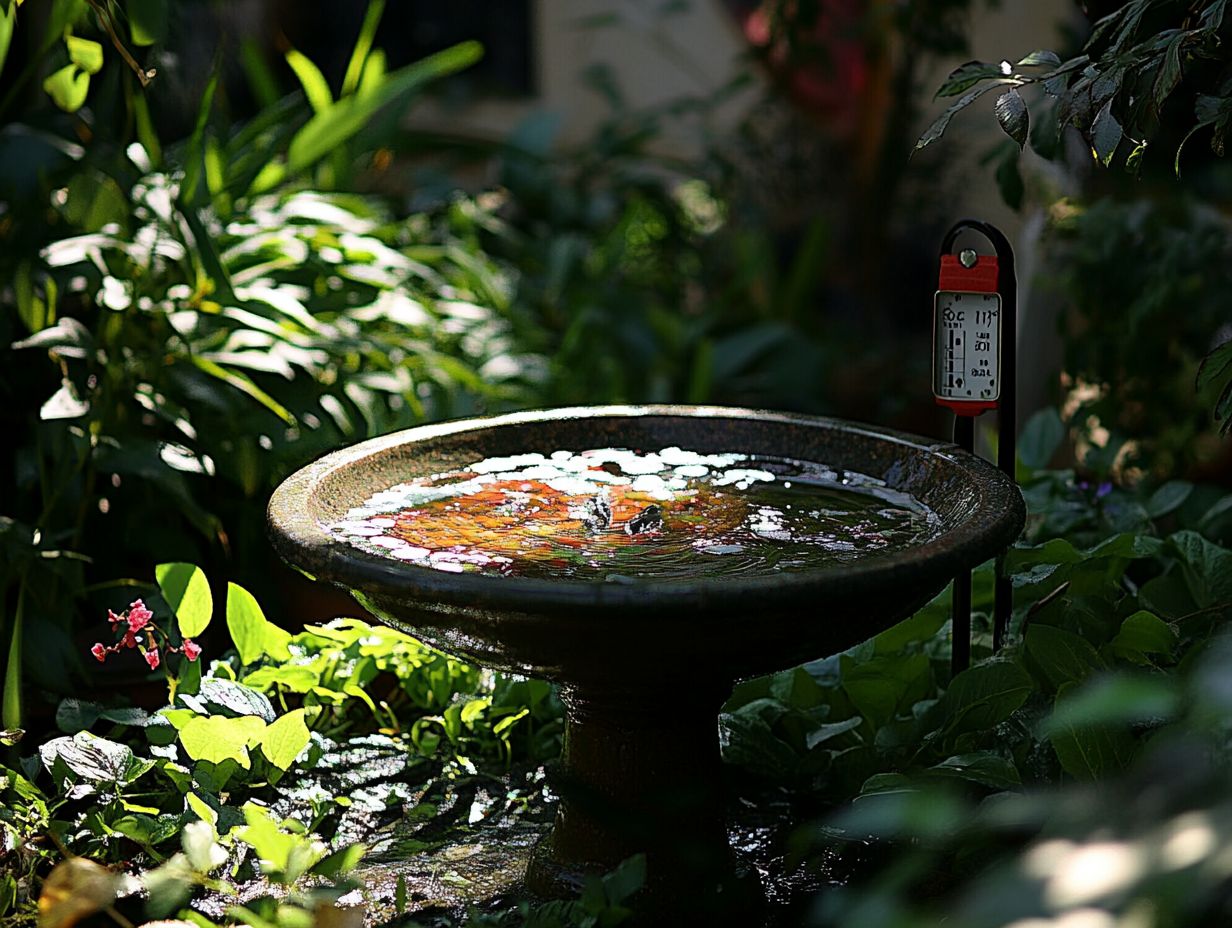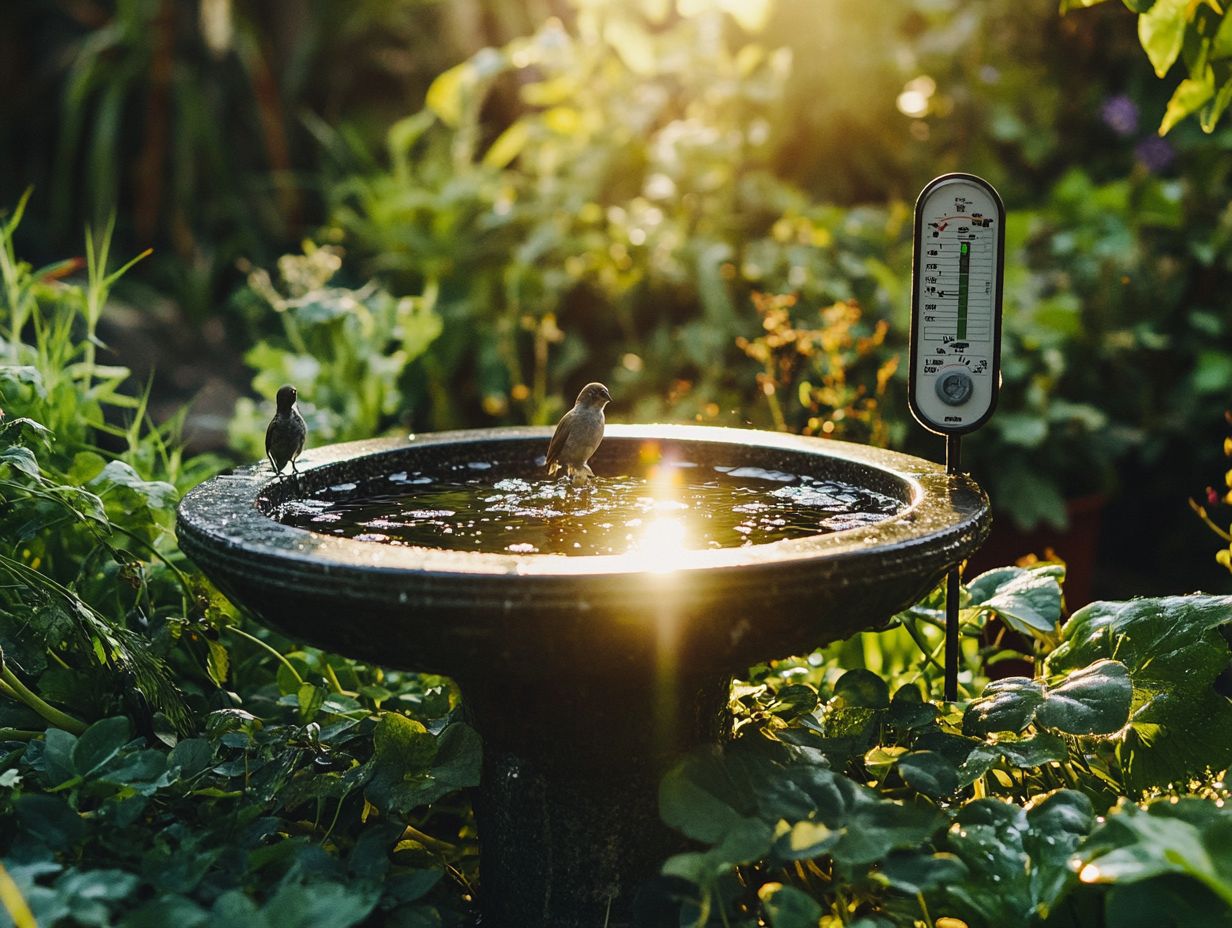The Science Behind Bird Bath Temperature
Bird baths are a splendid addition to your backyard, offering hydration and a refreshing splash for your feathered friends.
The temperature of the water can greatly influence bird behavior and health. It’s crucial for your birds’ well-being to understand how various factors ranging from weather conditions to the strategic placement of the bath affect water temperature. This knowledge is essential for creating an inviting and safe haven for birds.
Get ready to uncover the optimal temperature for bird baths, the tools you can use to monitor and adjust it, and the common misconceptions that could lead you off course.
Delve into the vital role that temperature plays in transforming your bird bath into a true sanctuary for wildlife.
Contents
- Key Takeaways:
- The Importance of Bird Bath Temperature
- Factors Affecting Bird Bath Temperature
- Optimal Temperature for Bird Baths
- How to Monitor and Adjust Bird Bath Temperature
- Common Misconceptions about Bird Bath Temperature
- Frequently Asked Questions
- What factors affect the temperature of a bird bath?
- Why is it important to monitor the temperature of a bird bath?
- How can I maintain a safe temperature for birds in my bird bath?
- What is the ideal temperature range for a bird bath?
- How does the temperature of a bird bath affect bird behavior?
- Can the temperature of a bird bath impact disease spread and predator safety?
Key Takeaways:

- Maintaining the right temperature in a heated bird bath is crucial for the health and well-being of birds.
- Weather conditions and placement are key factors that affect bird bath temperature.
- The recommended temperature range for bird baths is between 70-75 degrees Fahrenheit.
The Importance of Bird Bath Temperature
The temperature of a bird bath is vital, especially in cold climates. A heated bird bath guarantees fresh drinking water for birds, even in freezing temperatures.
Understanding how to keep the right temperature benefits birds that rely on natural water sources for hydration and grooming, especially during harsh winters. Experts in wildlife science, such as Alex Van der Walt, emphasize how crucial it is for birds to have reliable water sources throughout the colder months.
Why Temperature Matters for Birds
Temperature is crucial for the survival of birds, as access to drinking water is essential for their hydration and overall well-being.
During icy winter months, birds become especially susceptible to harsh conditions, and fluctuations in temperature can directly influence their feeding habits, migratory routes, and even their immune systems. Fresh water sources dwindle when temperatures drop, intensifying competition among avian species. Without reliable access to liquid water, birds risk dehydration, making it vital for them to discover alternative hydration sources.
Prolonged exposure to cold can sap their energy reserves, compelling these feathered beings to seek warmer havens while they search for food and drinking water to sustain their health.
Factors Affecting Bird Bath Temperature
Several factors influence the temperature of a bird bath, including the prevailing weather conditions, its location, and whether there s an outdoor power source available to maintain warmth during colder climates, ensuring your bird bath remains frost-free.
Weather Conditions

Weather conditions have a substantial impact on the temperature of your bird baths, especially during the winter months when snow and freezing temperatures can lead to icy formations.
These daunting realities present a challenge for your feathered friends, who depend on open water sources for drinking and bathing. Simply providing a bird bath may not suffice; it demands careful consideration.
To ensure usability, you might want to invest in a heated bird bath or place a light source nearby to keep the water from freezing. Regularly breaking the ice can also be advantageous, giving birds a reliable way to hydrate.
By maintaining accessible water in the midst of the biting cold, you can play a crucial role in supporting your avian community throughout the winter months.
Location and Placement
The location and placement of your bird bath are crucial for ensuring it gets ample sunlight while remaining safe from predators.
Select a sunny spot to warm the water and attract birds more frequently. This choice also enhances the aesthetic appeal of your garden.
For safety, place the bath away from thick shrubs and trees. This keeps birds safe from predators.
A good outdoor power source can improve your bird bath’s functionality. During colder months, a heated option prevents the water from freezing, providing birds with a reliable source of hydration. This transforms your garden into a year-round sanctuary for feathered friends.
Optimal Temperature for Bird Baths
The optimal temperature for a heated bird bath is essential to ensure it serves as a reliable source of fresh water for birds during winter. Maintaining the right temperature creates a welcoming environment that helps your feathered friends thrive even in the coldest conditions.
Recommended Temperature Range
A heated bird bath should maintain a temperature range of 32 F to 50 F. This ensures birds have access to drinking water even in cold climates.
You can easily manage this optimal temperature with modern thermostats and reliable outdoor water heaters. Wildlife experts stress the importance of consistent warmth, as various bird species depend on readily available water sources for survival during frigid weather.
Set a thermostat to regulate the heating element and keep the bird bath functional, even in harsh winter conditions. Regular checks and adjustments are wise to accommodate extreme temperature fluctuations. This guarantees a safe, warm oasis for your feathered visitors as they hydrate throughout their daily routines.
How to Monitor and Adjust Bird Bath Temperature

Monitoring and adjusting the temperature of a bird bath is crucial for creating an inviting environment for birds. By using tools like a thermostat controller and long power cords, you can ensure fresh water remains accessible at all times, fostering a comfortable space for your feathered friends.
Tools and Techniques for Temperature Control
Utilizing a thermostat controller for your heated bird bath allows for precise temperature control, ensuring the water stays at an optimal level.
This setup prevents the water from freezing during the colder months and creates an inviting oasis for birds to enjoy a refreshing drink or a quick dip.
When paired with long power cords, you can easily position the bath in sunny spots or high-traffic areas for birds. These cords provide a safe and reliable power source, eliminating the hassle of tricky extensions or the dangers of outdoor outlets.
Together, these tools transform your space into a sanctuary for birds, promoting hydration and cleanliness while enriching their environment.
Common Misconceptions about Bird Bath Temperature
You may encounter misconceptions about bird bath temperature, especially concerning the necessity of a heated bird bath for winter bird care. Understanding these nuances is essential for providing the best environment for our feathered friends.
Don’t let your feathered friends go thirsty this winter! Start creating your bird-friendly garden today!
Dispelling Myths and Addressing Concerns
Let s clear up the myths surrounding heated bird baths! Many people worry about their effectiveness and the need for winter care.
Some think heated baths could disrupt natural bird behaviors. Wildlife experts argue that providing accessible water during cold months is vital for bird survival.
Birds need hydration all year. In freezing temperatures, natural water sources can often be out of reach.
Heated bird baths prevent ice formation and attract a variety of bird species, promoting a diverse ecosystem.
Understanding this can ease doubts and improve care practices. Keep birds hydrated and healthy throughout the winter!
Frequently Asked Questions

What factors affect the temperature of a bird bath?
The main factors are the bath’s location, the amount of sunlight it gets, and the surrounding temperature.
Why is it important to monitor the temperature of a bird bath?
Extreme temperatures can harm birds and hinder their ability to stay clean and hydrated.
How can I maintain a safe temperature for birds in my bird bath?
Place it in a shady area to keep the water cool. You can also add ice cubes or use a heater in colder months.
What is the ideal temperature range for a bird bath?
The best temperature range is between 68-78 degrees Fahrenheit. This allows birds to bathe and drink comfortably.
How does the temperature of a bird bath affect bird behavior?
Extreme temperatures can make birds avoid using it. This can lead to dehydration and improper grooming.
Can the temperature of a bird bath impact disease spread and predator safety?
Yes, overly warm water can promote harmful bacteria and algae growth, spreading diseases among birds. Keep it safe and clean!






